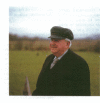Abstract
Phaeochromocytoma is rare and usually presents as paroxysmal or sustained hypertension; none the less, it can also cause severe acute pulmonary oedema in normotensive individuals. Six patients with phaeochromocytoma presenting in Cornwall and West Devon between 1982 and 1986 are described. Five of them died of pulmonary oedema within 24 hours of the onset of symptoms. At necropsy all five had normal sized hearts and in the four hearts examined by histology there was evidence of catecholamine induced heart disease in the form of focal myocardial necrosis. The sixth patient presented with arterial spasms and pulmonary oedema. Surgical removal of the causative tumour was successful in this patient.
Full text
PDF



Images in this article
Selected References
These references are in PubMed. This may not be the complete list of references from this article.
- Baker G., Zeller N. H., Weitzner S., Leach J. K. Pheochromocytoma without hypertension presenting as cardiomyopathy. Am Heart J. 1972 May;83(5):688–693. doi: 10.1016/0002-8703(72)90410-3. [DOI] [PubMed] [Google Scholar]
- Bloom S. Catecholamine cardiomyopathy. N Engl J Med. 1987 Oct 1;317(14):900–901. doi: 10.1056/NEJM198710013171413. [DOI] [PubMed] [Google Scholar]
- Bloom S., Davis D. L. Calcium as mediator of isoproterenol-induced myocardial necrosis. Am J Pathol. 1972 Dec;69(3):459–470. [PMC free article] [PubMed] [Google Scholar]
- Cho T., Tanimura A., Saito Y. Catecholamine-induced cardiopathy accompanied with pheochromocytoma. Acta Pathol Jpn. 1987 Jan;37(1):123–132. doi: 10.1111/j.1440-1827.1987.tb03140.x. [DOI] [PubMed] [Google Scholar]
- Fripp R. R., Lee J. C., Downing S. E. Inotropic responsiveness of the heart in catecholamine cardiomyopathy. Am Heart J. 1981 Jan;101(1):17–21. doi: 10.1016/0002-8703(81)90378-1. [DOI] [PubMed] [Google Scholar]
- Garcia R., Jennings J. M. Pheochromocytoma masquerading as a cardiomyopathy. Am J Cardiol. 1972 Apr;29(4):568–571. doi: 10.1016/0002-9149(72)90452-3. [DOI] [PubMed] [Google Scholar]
- Haft J. I. Cardiovascular injury induced by sympathetic catecholamines. Prog Cardiovasc Dis. 1974 Jul-Aug;17(1):73–86. doi: 10.1016/0033-0620(74)90039-5. [DOI] [PubMed] [Google Scholar]
- Imperato-McGinley J., Gautier T., Ehlers K., Zullo M. A., Goldstein D. S., Vaughan E. D., Jr Reversibility of catecholamine-induced dilated cardiomyopathy in a child with a pheochromocytoma. N Engl J Med. 1987 Mar 26;316(13):793–797. doi: 10.1056/NEJM198703263161307. [DOI] [PubMed] [Google Scholar]
- KLINE I. K. Myocardial alterations associated with pheochromocytomas. Am J Pathol. 1961 May;38:539–551. [PMC free article] [PubMed] [Google Scholar]
- Kuska J., Kokot F., Drab M., Drobisz M. Czestoś wystepowania poszczególnych postaci etiologicznych nadciśnienia tetniczego na podstawie analizy 5155 przypadków. Kardiol Pol. 1988;31(1):38–47. [PubMed] [Google Scholar]
- Moorhead E. L., 2nd, Caldwell J. R., Kelly A. R., Morales A. R. The diagnosis of pheochromocytoma. Analysis of 26 cases. JAMA. 1966 Jun 27;196(13):1107–1113. [PubMed] [Google Scholar]
- Page L. B., Raker J. W., Berberich F. R. Pheochromocytoma with predominant epinephrine secretion. Am J Med. 1969 Oct;47(4):648–652. doi: 10.1016/0002-9343(69)90195-8. [DOI] [PubMed] [Google Scholar]
- Rona G. Catecholamine cardiotoxicity. J Mol Cell Cardiol. 1985 Apr;17(4):291–306. doi: 10.1016/s0022-2828(85)80130-9. [DOI] [PubMed] [Google Scholar]
- Rosenbaum J. S., Billingham M. E., Ginsburg R., Tsujimoto G., Lurie K. G., Hoffman B. B. Cardiomyopathy in a rat model of pheochromocytoma. Morphological and functional alterations. Am J Cardiovasc Pathol. 1988;1(3):389–399. [PubMed] [Google Scholar]
- Ross E. J., Griffith D. N. The clinical presentation of phaeochromocytoma. Q J Med. 1989 Jun;71(266):485–496. [PubMed] [Google Scholar]
- SZAKACS J. E., CANNON A. L-Norepinephrine myocarditis. Am J Clin Pathol. 1958 Nov;30(5):425–434. doi: 10.1093/ajcp/30.5.425. [DOI] [PubMed] [Google Scholar]
- Singal P. K., Kapur N., Dhillon K. S., Beamish R. E., Dhalla N. S. Role of free radicals in catecholamine-induced cardiomyopathy. Can J Physiol Pharmacol. 1982 Nov;60(11):1390–1397. doi: 10.1139/y82-207. [DOI] [PubMed] [Google Scholar]
- Van Vliet P. D., Burchell H. B., Titus J. L. Focal myocarditis associated with pheochromocytoma. N Engl J Med. 1966 May 19;274(20):1102–1108. doi: 10.1056/NEJM196605192742002. [DOI] [PubMed] [Google Scholar]
- Yankopoulos N. A., Montero A. C., Curd W. G., Jr, Kahil M. E., Condon R. E. Observations on myocardial function during chronic catecholamine oversecretion. Chest. 1974 Nov;66(5):585–587. doi: 10.1378/chest.66.5.585. [DOI] [PubMed] [Google Scholar]



